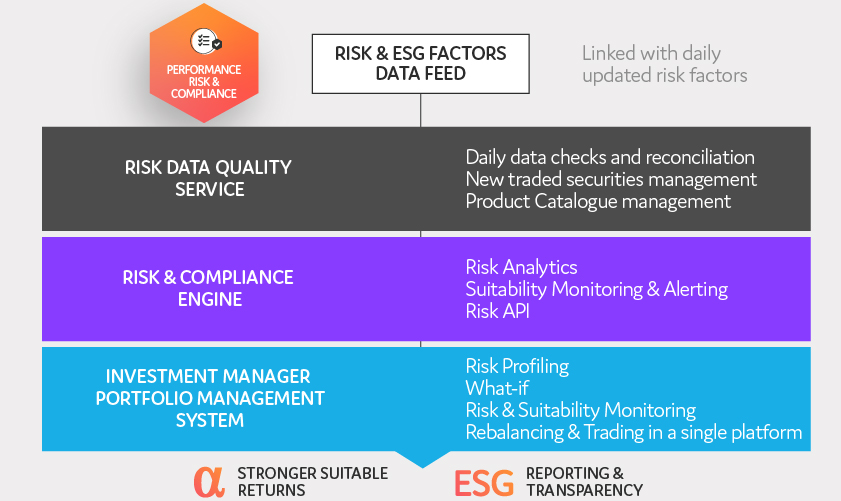
PAID CONTENT
The ability to align, differentiate, and activate authentic alpha generation capabilities through better alignment between ex-ante decisions and ex-post performance is critical, but there is a broad gamut of enhanced capabilities which investment firms can pursue.
Through a total portfolio approach, Investment Managers can validate and verify their investment decisions against potential impacts and verify effects at any stage of the process.
This requires a robust and fully integrated process, supported by a proven approach to risk mitigation and, at the same time, able to provide clear and transparent reporting to clients on investment strategies and portfolio management decisions.
Portfolio and Risk Managers usually face challenges of disparate information systems, which create operational limitations that directly influence the returns they could generate. Organisations that proactively manage risk are more risk-aware and better at tailoring risk to get a higher return on their portfolios.
Finding a real integrated solution for Risk Management
But how to recognise a true End-to-End Risk-Aware Investment Management solution?
First, by a Risk Data Quality service able to take the Risk & ESG factors as input, and then perform a daily validation and revision of risk data to ensure that all calculated analytics are robust and reliable, managing exceptions and taking corrective actions.
Then, you need a Risk Engine that calculates risk analytics ensuring a comprehensive approach to identify the correct level of risk, together with specific client characteristics such as time horizon, cash flow and objectives.
Finally, with a Portfolio Management tool for asset allocation to build optimised, sustainable and suitable portfolios on risk factors, asset classes and securities selection, in line with risk profiles and target markets.
This way, investment proposals are personalised, tested against compliance rules, clients’ constraints, MIFID-II total cost of ownership in aggregated and analytic form.
A complete risk-aware investment process can also provide Investment Managers with real-time analytics on expected return and risk, what-if and stress testing scenarios.
Furthermore, risk contribution and correlation analysis empower Portfolio Managers to control the contribution of each holding to the overall risk. And a continuous monitoring of market risk and other portfolio factors, such as ESG analysis and exceptions workflows, allows proactive alerting on outliers and management of pre-trade and post-trade risk.
Selecting a functionally-rich risk engine
When selecting a risk engine, a performing solution should include a calculation engine to obtain ex-ante risk measures to analyse portfolio risks for Customer Relationship Managers, Portfolio and Risk Managers, to monitor single positions or portfolios as a whole, simulate the potential impact of different investment decisions and support portfolio risk calculations from a regulatory perspective.
A wide set of metrics allows users to define their own risk criteria according to their business model calculated on single assets, asset classes or the entire portfolio, providing information on potential losses, correlation among securities and dispersion measures, related to different risk categories, such as market, credit and liquidity risks.
Sustainability at the center of the investment strategy
According to a recent survey we conducted, client demand is the main driver of ESG integration in investment management firms. Indeed, although integrating ESG into a risk management framework across the client lifecycle is a challenge for them, an integrated ESG-ready solution increases the chance of delivering operational efficiency and empowering client engagement. Nowadays, investors expect a rich digital experience and to be able to see tailored ESG reports on the go, with information such as individual ESG scores as well as their carbon footprint and what impact their portfolio has had on the environment.
ESG is consequently a real differentiator for firms in terms of competitive advantage.
A well-designed risk engine should then support the entire sustainable investment lifecycle, by capturing client ESG preferences, integrating multiple data sources to assign ESG score, calculating ESG analytics and ESG impact analysis on investments, simulating what-if scenarios, monitoring post trade ESG compliance rules whilst proactively alerting and reporting to clients their ESG investments.
Five pillars for a risk-aware, fully integrated investment process
When evaluating a solution to provide a solid approach to risk and portfolio management decisions, these are the fundamental aspects to take into consideration:
- It guarantees the data quality 24/7, ensuring that the resulting analytics are robust, reliable, validated and harmonized
- Performs a risk contribution and correlation analysis, to monitor the contribution of each portfolio linked to the overall risk
- Ensures that investment proposals are personalised and tested against compliance rules and clients’ constraints
- Aligns end-to-end processes between trading/investment, risk and product control
- Manages exceptions and takes corrective actions


